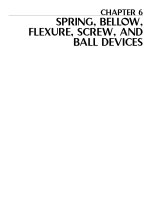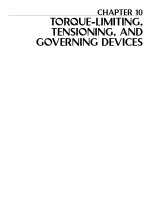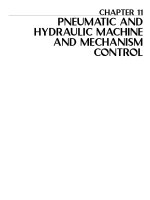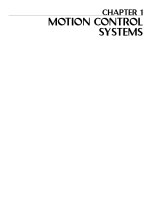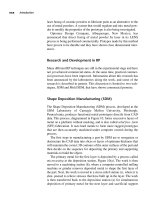Mechanisms and Mechanical Devices Sourcebook - Chapter 6
Bạn đang xem bản rút gọn của tài liệu. Xem và tải ngay bản đầy đủ của tài liệu tại đây (1.62 MB, 25 trang )
CHAPTER 6
SPRING, BELLOW,
FLEXURE, SCREW, AND
BALL DEVICES
Sclater Chapter 6 5/3/01 12:24 PM Page 173
FLAT SPRINGS IN MECHANISMS
174
Constant force is approached because of the length of this U-spring. Don’t
align the studs or the spring will fall.
A flat-wire sprag is straight until the knob is
assembled: thus tension helps the sprag to
grip for one-way clutching.
Easy positioning of the slide is possible when
the handle pins move a grip spring out of con-
tact with the anchor bar.
A spring-loaded slide will always return to its original
position unless it is pushed until the spring kicks out.
Increasing support area as the load
increases on both upper and lower
platens is provided by a circular spring.
Nearly constant tension in the spring, as well
as the force to activate the slide, is provided by
this single coil.
This volute spring lets the shaft be moved
closer to the frame, thus allowing maximum
axial movement.
Sclater Chapter 6 5/3/01 12:24 PM Page 174
These mechanisms rely on a flat
spring for their efficient actions.
175
Indexing is accomplished simply,
efficiently, and at low cost by flat-
spring arrangement shown here.
This cushioning device imparts
rapid increase of spring tension
because of the small pyramid
angle. Its rebound is minimum.
This spring-mounted disk changes its center position as the handle is rotated to
move the friction drive. It also acts as a built-in limit stop.
A return-spring ensures that the oper-
ation handle of this two-direction drive
will always return to its neutral position.
This hold-down clamp has its
flat spring assembled with an ini-
tial twist to provide a clamping
force for thin material.
Sclater Chapter 6 5/3/01 12:24 PM Page 175
POP-UP SPRINGS GET NEW BACKBONE
An addition to the family of retractable
coil springs, initially popular for use as
antennas, holds promise of solving one
problem in such applications: lack of tor-
sional and flexural rigidity when
extended. A pop-up boom that locks
itself into a stiffer tube has been made.
In two previous versions—De
Havilland Aircraft’s Stem and Hunter
Springs’s Helix—rigidity was obtained
by permitting the material to overlap. In
Melpar’s design, the strip that unrolls
from the drum to form the cylindrical
mast has tabs and slots that interlock to
produce a strong tube.
Melpar has also added a row of perfo-
rations along the center of the strip to aid
in accurate control of the spring’s length
during extension or contraction. This
adds to the spring’s attractiveness as a
positioning device, besides its estab-
lished uses as antennas for spacecraft and
portable equipment and as gravity gradi-
ent booms and sensing probes.
Curled by heat. Retractable, pre-
stressed coil springs have been in the
technical news for many years, yet most
manufacturers have been rather close-
mouthed about exactly how they covert a
strip of beryllium copper or stainless
steel into such a spring.
In its Helix, Hunter induced the pre-
stressing at an angle to the axis of the
strip, so the spring uncoils helically; De
Havilland and Melpar prestress the mate-
rial along the axis of the strip.
A prestressing technique was worked
out by John J. Park of the NASA
Goddard Center. Park found early in his
assignment that technical papers were
lacking on just how a metal strip can be
given a new “memory” that makes it curl
longitudinally unless restrained.
Starting from scratch, Park ran a
series of experiments using a glass tube,
0.65 in. ID, and strips of beryllium cop-
per allow, 2 in. wide and 0.002 in. thick.
He found it effective to roll the alloy
strip lengthwise into the glass tube and
then to heat it in a furnace. Test strips
were then allowed to cool down to room
temperature.
It was shown that the longer the treat-
ment and the hotter the furnace time, the
more tightly the strip would curl along its
length, producing a smaller tube. For
example, a test strip heated at 920° F for
5 min would produce a tube that
remained at the 0.65-in. inside diameter
of the glass holder; at 770 F, heating for
even 15 min produced a tube that would
expand to an 0.68-in. diameter.
By proper correlation of time and
temperature in the furnace, Park sug-
gested that a continuous tube-forming
process could be set up and segments of
the completed tube could be cut off at the
lengths desired.
176
Sclater Chapter 6 5/3/01 12:24 PM Page 176
TWELVE WAYS TO PUT SPRINGS TO WORK
Variable-rate arrangements, roller positioning,
space saving, and other ingenious ways
to get the most from springs.
177
This setup provides a variable rate with a sudden change
from a light load to a heavy load by limiting the low-rate
extension with a spring.
This mechanism provides a three-step rate change at prede-
termined positions. The lighter springs will always compress
first, regardless of their position.
This differential-rate linkage sets the actuator
stroke under light tension at the start, then
allows a gradual transition to heavier tension.
This compressing mechanism has a dual rate for double-
action compacting. In one direction pressure is high, but in
the reverse direction pressure is low.
Roller positioning by a tightly wound
spring on the shaft is provided by this
assembly. The roller will slide under
excess end thrust.
A short extension of the spring for a long
movement of the slide keeps the tension
change between maximum and minimum low.
Sclater Chapter 6 5/3/01 12:24 PM Page 177
178
Increased tension for the same movement is
gained by providing a movable spring mount
and gearing it to the other movable lever.
This pin grip is a spring that holds a pin by friction
against end movement or rotation, but lets the pin be
repositioned without tools.
A close-wound spring is attached to
a hopper, and it will not buckle when it
is used as a movable feed-duct for
nongranular material.
Toggle action here ensures that the gear-
shift lever will not inadvertently be thrown
past its neutral position.
Tension varies at a different rate when
the brake-applying lever reaches the posi-
tion shown. The rate is reduced when the
tilting lever tilts.
The spring wheel helps to distribute deflection
over more coils that if the spring rested on the cor-
ner. The result is less fatigue and longer life.
Sclater Chapter 6 5/3/01 12:24 PM Page 178
OVERRIDING SPRING MECHANISMS FOR
LOW-TORQUE DRIVES
Fig. 1 Unidirectional override. The take-off lever of this mechanism can rotate nearly
360°. Its movement is limited only by one stop pin. In one direction, motion of the driving
shaft is also impeded by the stop pin. But in the reverse direction the driving shaft is
capable or rotating approximately 270° past the stop pin. In operation, as the driving
shaft is turned clockwise, motion is transmitted through the bracket to the take-off lever.
The spring holds the bracket against the drive pin. When the take-off lever has traveled
the desired limit, it strikes the adjustable stop pin. However, the drive pin can continue
its rotation by moving the bracket away from the drive pin and winding up the spring. An
overriding mechanism is essential in instruments employing powerful driving elements,
such as bimetallic elements, to prevent damage in the overrange regions.
Fig. 2 Two-directional override. This mechanism is similar to that described under
Fig. 1, except that two stop pins limit the travel of the take-off lever. Also, the incoming
motion can override the outgoing motion in either direction. With this device, only a
small part of the total rotation of the driving shaft need be transmitted to the take-off
lever, and this small part can be anywhere in the range. The motion of the deriving shaft
is transmitted through the lower bracket to the lower drive pin, which is held against the
bracket by the spring. In turn, the lower drive pin transfers the motion through the upper
bracket to the upper drive pin. A second spring holds this pin against the upper drive
bracket. Because the upper drive pin is attached to the take-off lever, any rotation of the
drive shaft is transmitted to the lever, provided it is not against either stop A or B. When
the driving shaft turns in a counterclockwise direction, the take-off lever finally strikes
against the adjustable stop
A. The upper bracket then moves away from the upper drive
pin, and the upper spring starts to wind up. When the driving shaft is rotated in a clock-
wise direction, the take-off lever hits adjustable stop
B, and the lower bracket moves
away from the lower drive pin, winding up the other spring. Although the principal appli-
cations for overriding spring arrangements are in instrumentation, it is feasible to apply
these devices in the drives of heavy-duty machines by strengthening the springs and
other load-bearing members.
Overriding spring mechanisms are widely
used in the design of instruments and controls.
All of the arrangements illustrated allow an
incoming motion to override the outgoing
motion whose limit has been reached. In an
instrument, for example, the spring mechanism
can be placed between the sensing and
indicating elements to provide overrange
protection. The dial pointer is driven positively
up to its limit before it stops while the input
shaft is free to continue its travel. Six of the
mechanisms described here are for rotary
motion of varying amounts. The last is for
small linear movements.
Fig. 3 Two-directional, limited-travel override. This mecha-
nism performs the same function as that shown in Fig. 2, except
that the maximum override in either direction is limited to about
40°. By contrast, the unit shown in Fig. 2 is capable of 270°
movement. This device is suited for applications where most of
the incoming motion is to be used, and only a small amount of
travel past the stops in either direction is required. As the arbor is
rotated, the motion is transmitted through the arbor lever to the
bracket.. The arbor lever and the bracket are held in contact by
spring B. The motion of the bracket is then transmitted to the
take-off lever in a similar manner, with spring A holding the take-
off lever until the lever engages either stops A or B. When the
arbor is rotated in a counterclockwise direction, the take-off lever
eventually comes up against the stop B. If the arbor lever contin-
ues to drive the bracket, spring A will be put in tension.
179
Sclater Chapter 6 5/3/01 12:24 PM Page 179
Fig. 4 Unidirectional, 90° override. This is a single
overriding unit that allows a maximum travel of 90°
past its stop. The unit, as shown, is arranged for
overtravel in a clockwise direction, but it can also be
made for a counterclockwise override. The arbor
lever, which is secured to the arbor, transmits the
rotation of the arbor to the take-off lever. The spring
holds the drive pin against the arbor lever until the
take-off lever hits the adjustable stop. Then, if the
arbor lever continues to rotate, the spring will be
placed in tension. In the counterclockwise direction,
the drive pin is in direct contact with the arbor lever
so that no overriding is possible.
Fig. 5 Two-directional, 90° override. This double-overriding mechanism allows a
maximum overtravel of 90° in either direction. As the arbor turns, the motion is carried
from the bracket to the arbor lever, then to the take-off lever. Both the bracket and the
take-off lever are held against the arbor lever by spring A and B. When the arbor is
rotated counterclockwise, the takeoff lever hits stop A. The arbor lever is held station-
ary in contact with the take-off lever. The bracket, which is fastened to the arbor,
rotates away from the arbor lever, putting spring A in tension. When the arbor is
rotated n a clockwise direction, the take-off lever comes against stop B, and the
bracket picks up the arbor lever, putting spring B in tension.
Fig. 6 Unidirectional, 90° override. This mech-
anism operates exactly the same as that shown in
Fig. 4. However, it is equipped with a flat spiral
spring in place of the helical coil spring used in
the previous version. The advantage of the flat
spiral spring is that it allows for a greater override
and minimizes the space required. The spring
holds the take-off lever in contact with the arbor
lever. When the take-off lever comes in contact
with the stop, the arbor lever can continue to
rotate and the arbor winds up the spring.
Fig. 7 Two-directional override, linear motion. The previous mechanisms were over-
rides for rotary motion. The device in Fig. 7 is primarily a double override for small linear
travel, although it could be used on rotary motion. When a force is applied to the input lever,
which pivots about point C, the motion is transmitted directly to the take-off lever through the
two pivot posts, A and B. The take-off lever is held against these posts by the spring. When
the travel causes the take-off lever to hit the adjustable stop A, the take-off lever revolves
about pivot post A, pulling away from pivot post B, and putting additional tension in the
spring. When the force is diminished, the input lever moves in the opposite direction until the
take-off lever contacts the stop B. This causes the take-off lever to rotate about pivot post B,
and pivot post A is moved away from the take-off lever.
180
Sclater Chapter 6 5/3/01 12:24 PM Page 180
SPRING MOTORS AND TYPICAL ASSOCIATED
MECHANISMS
Many applications of spring motors in clocks, motion picture
cameras, game machines, and other mechanisms offer practical
ideas for adaptation to any mechanism that is intended to operate
for an appreciable length of time. While spring motors are usu-
ally limited to comparatively small power application where
other sources of power are unavailable or impracticable, they
might also be useful for intermittent operation requiring compar-
atively high torque or high speed, using a low-power electric
motor or other means for building up energy.
181
Sclater Chapter 6 5/3/01 12:24 PM Page 181
The accompanying patented spring motor designs show vari-
ous methods for the transmission and control of spring-motor
power. Flat-coil springs, confined in drums, are most widely used
because they are compact, produce torque directly, and permit
long angular displacement. Gear trains and feedback mecha-
nisms reduce excess power drain so that power can be applied for
a longer time. Governors are commonly used to regulate speed.
182
Sclater Chapter 6 5/3/01 12:24 PM Page 182
